Calculation of Intake Oxygen Concentration through Intake CO2 Measurement and Evaluation of Its Effect on Nitrogen Oxide Prediction Accuracy in a Heavy-Duty Diesel Engine
Abstract
:1. Introduction
- Direct optimization of the control strategy for the main powertrain components (e.g., engine, transmission) to maximize their performance.
- Development of a model-based global powertrain energy-manager supervisor (EMS), which coordinates the different energy sources and optimizes their utilization, according to the current driving situation.
- A more comprehensive understanding of the mission (e.g., eHorizon, mission-based learning) to enable long-term optimization strategies.
1.1. Intake O2 Estimation: State of the Art and Advantages of the Proposed Procedure
1.2. Summary on the Combustion Controller and Its Performance
2. Materials and Methods
- 4.
- Dataset 1: steady-state and transient tests for a 3L diesel engine.
- 5.
- Dataset 2: transient tests for an 11L prototype diesel engine.
- 6.
- A complete engine map (a total of 123 experimental points were acquired).
- 7.
- An EGR-sweep at some key-points. An EGR percentage of 0 to 50% was explored in these tests, with different levels of trapped air mass (a total of 162 experimental points were acquired).
- 8.
- Sweep tests of the start of injection of the main pulse (SOImain) and injection pressure (pf), which were carried out for different key points. SOImain was varied by ±6 crank angle degrees with respect the nominal values, and pf was varied by ±20% with respect to the nominal values. A pilot-main injection strategy was adopted (25 experimental points were acquired).
- 9.
- A transient test, which was performed at constant engine speed and while varying the engine load along a “hat-shaped” profile.
3. Conceptualization of the New Intake O2 Estimation Method
3.1. Description of the General Approach
- 10.
- a N2,air, which represents the number of nitrogen moles in the fresh air.
- 11.
- c O2,air, which represents the number of oxygen moles in the fresh air.
- 12.
- d CO2,air, which represents the number of carbon dioxide moles in the fresh air.
- 13.
- b H2O,air, which represents the number of water moles in the fresh air due to ambient humidity.
- 14.
- i CO2,EGR/B, which represents the number of carbon dioxide moles in the EGR contribution due to combustion.
- 15.
- j H2O,EGR/B, which represents the number of water-vapor moles in the EGR contribution due to combustion.
- 16.
- h N2,EGR/B, which represents the number of nitrogen moles in the EGR contribution due to combustion.
- 17.
- e CO2,EGR/UB, which represents the number of carbon dioxide moles in the fresh air that is recirculated.
- 18.
- f H2O,EGR/UB, which represents the number of water-vapor moles in the fresh air that is recirculated due to ambient humidity.
- 19.
- k O2,EGR/UB, which represents the number of oxygen moles in the fresh air that is recirculated.
- 20.
- g N2,EGR/UB, which represents the number of nitrogen moles in the fresh air that is recirculated.
hN2,EGR/B + iCO2,EGR/B + jH2O,EGR/B + kO2,EGR/UB = L
3.1.1. Evaluation of the ‘(b + f)/L’ Parameter
3.1.2. Evaluation of the ‘h/L’, ‘i/L’ and ‘j/L’ Terms
4. Results and Discussion
4.1. Validation of the Procedure under Steady-State Conditions
4.2. Validation of the Procedure under Transient Conditions
4.3. Validation of the NOx Model Using the Intake Oxygen Concentration Estimated by Means of the New Procedure
- 21.
- Engine operation with the controller enabled and the nominal NOx target (blue lines).
- 22.
- Engine operation with the controller enabled and the NOx target increased by 20% with respect to the nominal target (magenta lines).
- 23.
- Engine operation with the controller enabled and the NOx target decreased by 20% with respect to the nominal target (green lines).
- 24.
- Engine operation with the controller enabled and the NOx target decreased by 40% with respect to the nominal target (black lines).
5. Conclusions
- -
- The new method provides similar results to those obtained from a previously detailed methodology based on a detailed combustion reaction since the difference in the results of the two procedures is in the ±0.01% range.
- -
- The absolute error between the measured and predicted intake O2 levels is in the ±0.15% range. It should be noted that the measured O2 levels are affected by the presence of residual water downstream of the cooler of the gas analyzer. The absolute error of the method is in the ±0.25% range, even when this effect is disregarded.
- -
- The good accuracy of the method was also confirmed over a transient test.
- -
- The developed procedure was also applied to verify the performance, in transient operation, of a previously developed NOx model on a heavy-duty 11L diesel engine. It was found that a significant improvement in the accuracy of the NOx model could be obtained with respect to the case in which an ECU (engine control unit)-derived O2 level was used, when the intake O2 concentration derived from the new method was given to the NOx model as input.
Author Contributions
Funding
Conflicts of Interest
Abbreviations
| BMEP | Brake mean effective pressure (bar) |
| CA | Crank angle (deg) |
| DT | Dwell time |
| ECU | Engine control unit |
| EGR | Exhaust gas recirculation |
| FMEP | Friction mean effective pressure (bar) |
| Habs | Absolute humidity of the air |
| IMEP | Indicated mean effective pressure (bar) |
| IMEPg | Gross indicated mean effective pressure (bar) |
| IMEPn | Net indicated mean effective pressure (bar) |
| IMPERIUM | Implementation of powertrain control for economic and clean real driving emission and fuel consumption |
| IRD | Infrared detector |
| m | Mass |
| Mass flow rate of fresh air | |
| Mass flow rate of EGR | |
| MFB50 | Crank angle at which 50% of the fuel mass fraction has burned (deg) |
| N | Engine rotational speed (1/min) |
| O2 | Intake charge oxygen concentration (%) |
| p | Pressure (bar) |
| pEMF | Exhaust manifold pressure (bar abs) |
| pf | Injection pressure (bar) |
| PFP | Peak firing pressure |
| pIMF | Intake manifold pressure (bar abs) |
| PMEP | Pumping mean effective pressure (bar) |
| PMD | Paramagnetic detector |
| q | Injected fuel volume quantity (mm3) |
| Qch | Chemical heat release |
| qf,inj | Total injected fuel volume quantity per cycle/cylinder |
| Qnet | Net heat release |
| RMSE | Root mean square error |
| SOI | Electric start of injection |
| SOImain | Electric start of injection of the main pulse |
| t | time |
| T | Temperature (K) |
| Tamb | Ambient temperature |
| TIMF | Intake manifold temperature |
| VGT | Variable geometry turbine |
| VPM | Virtual pressure model |
References
- Johanssonn, I.; Jin, J.; Ma, X.; Pettersson, H. Look-ahead speed planning for heavy-duty vehicle platoons using traffic information. Transp. Res. Procedia 2017, 22, 561–569. [Google Scholar] [CrossRef]
- Chen, Y.; Rozkvas, N.; Lazar, M. Driving Mode Optimization for Hybrid Trucks Using Road and Traffic Preview Data. Energies 2020, 13, 5341. [Google Scholar] [CrossRef]
- Zhao, J.; Hu, Y.; Xie, F.; Li, X.; Sun, Y.; Sun, H.; Gong, X. Modeling and Integrated Optimization of Power Split and Exhaust Thermal Management on Diesel Hybrid Electric Vehicles. Energies 2021, 14, 7505. [Google Scholar] [CrossRef]
- Wang, H.; Zhong, X.; Ma, T.; Zheng, Z.; Yao, M. Model Based Control Method for Diesel Engine Combustion. Energies 2020, 13, 6046. [Google Scholar] [CrossRef]
- Samuel, J.; Ramesh, A. An Improved Physics-Based Combustion Modeling Approach for Control of Direct Injection Diesel Engines. SAE Int. J. Engines 2020, 13, 457–472. [Google Scholar] [CrossRef]
- Norouzi, A.; Heidarifar, H.; Shahbakhti, M.; Koch, C.R.; Borhan, H. Model Predictive Control of Internal Combustion Engines: A Review and Future Directions. Energies 2021, 14, 6251. [Google Scholar] [CrossRef]
- Imperium Project Information. Available online: http://www.imperium-project.eu/project-information/ (accessed on 12 October 2021).
- Danninger, A.; Armengaud, E.; Milton, G.; Lütznerc, J.; Haksteged, B.; Zurlo, G.; Schöni, A.; Lindbergg, J.; Krainer, F. IMPERIUM—IMplementation of Powertrain Control for Economic and Clean Real driving emIssion and fuel ConsUMption. In Proceedings of the 7th Transport Research Arena TRA, Vienna, Austria, 16–19 April 2018. [Google Scholar]
- Finesso, R.; Hardy, G.; Mancarella, A.; Marello, O.; Mittica, A.; Spessa, E. Real-Time Simulation of Torque and Nitrogen Oxide Emissions in an 11.0 L Heavy-Duty Diesel Engine for Model-Based Combustion Control. Energies 2019, 12, 460. [Google Scholar] [CrossRef] [Green Version]
- Cococcetta, F.; Finesso, R.; Hardy, G.; Marello, O.; Spessa, E. Implementation and Assessment of a Model-Based Controller of Torque and Nitrogen Oxide Emissions in an 11 L Heavy-Duty Diesel Engine. Energies 2019, 12, 4704. [Google Scholar] [CrossRef] [Green Version]
- Finesso, R.; Hardy, G.; Maino, C.; Marello, O.; Spessa, E. A New Control-Oriented Semi-Empirical Approach to Predict Engine-Out NOx Emissions in a Euro VI 3.0 L Diesel Engine. Energies 2017, 10, 1978. [Google Scholar] [CrossRef] [Green Version]
- Nakayama, S.; Fukuma, T.; Matsunaga, A.; Miyake, T.; Wakimoto, T. A New Dynamic Combustion Control Method Based on Charge Oxygen Concentration for Diesel Engines. SAE Tech. Pap. Ser. 2003, 1, 3181. [Google Scholar] [CrossRef]
- Nakayama, S.; Ibuki, T.; Hosaki, H.; Tominaga, H. An Application of Model Based Combustion Control to Transient Cycle-by-Cycle Diesel Combustion. SAE Tech. Pap. Ser. 2008, 1, 850–860. [Google Scholar] [CrossRef]
- Catania, A.; Finesso, R.; Spessa, E. Real-Time Calculation of EGR Rate and Intake Charge Oxygen Concentration for Misfire Detection in Diesel Engines. SAE Tech. Pap. Ser. 2011, 24, 0149. [Google Scholar] [CrossRef]
- Malan, S.; Ventura, L. Intake O 2 Concentration Estimation in a Turbocharged Diesel Engine through NOE. SAE Int. J. Adv. Curr. Prac. Mobil. 2021, 3, 864–871. [Google Scholar] [CrossRef]
- Rengarajan, S.; Sarlashkar, J.; Roecker, R.; Anderson, G. Estimation of Intake Oxygen Mass Fraction for Transient Control of EGR Engines. SAE Tech. Paper Ser. 2018, 1, 0868. [Google Scholar] [CrossRef]
- Arsie, I.; Cricchio, A.; Pianese, C.; De Cesare, M. Real-Time Estimation of Intake O2 Concentration in Turbocharged Common-Rail Diesel Engines. SAE Int. J. Engines 2013, 6, 237–245. [Google Scholar] [CrossRef]
- Shin, B.; Chi, Y.; Kim, M.; Dickinson, P.; Pekar, J.; Ko, M. Model Predictive Control of an Air Path System for Multi-Mode Operation in a Diesel Engine; SAE International: Warrendale, PA, USA, 2020. [Google Scholar] [CrossRef]
- Min, K.; Shin, J.; Jung, D.; Han, M.; Sunwoo, M. Estimation of Intake Oxygen Concentration Using a Dynamic Correction State with Extended Kalman Filter for Light-Duty Diesel Engines. J. Dyn. Sys. Meas. Control 2018, 140, 011013. [Google Scholar] [CrossRef]
- Diop, S.; Moraal, P.E.; Kolmanovsky, I.V.; van Nieuwstadt, M. Intake oxygen concentration estimation for DI diesel engines. In Proceedings of the 1999 IEEE International Conference on Control Applications, Kohala Coast, HI, USA, 22–27 August 1999; pp. 852–857. [Google Scholar] [CrossRef]
- Zhang, Q.; Wen, B.; Zhang, X.; Wu, K.; Wu, X.; Zhang, Y. In-Cylinder Oxygen Concentration Estimation Based on Virtual Measurement and Data Fusion Algorithm for Turbocharged Diesel Engines. Appl. Sci. 2021, 11, 7594. [Google Scholar] [CrossRef]
- D’Ambrosio, S.; Finesso, R.; Spessa, E. Calculation of mass emissions, oxygen mass fraction and thermal capacity of the inducted charge in SI and diesel engines from exhaust and intake gas analysis. Fuel 2011, 90, 152–166. [Google Scholar] [CrossRef]
- Finesso, R.; Spessa, E.; Yang, Y. Development and Validation of a Real-Time Model for the Simulation of the Heat Release Rate, In-Cylinder Pressure and Pollutant Emissions in Diesel Engines. SAE Int. J. Engines 2016, 9, 322–341. [Google Scholar] [CrossRef]
- Orthaber, G.C.; Chmela, F.G. Rate of Heat Release Prediction for Direct Injection Diesel Engines Based on Purely Mixing Controlled Combustion. SAE Tech. Paper Ser. 1999, 108, 152–160. [Google Scholar] [CrossRef]
- Egnell, R. A Simple Approach to Studying the Relation between Fuel Rate Heat Release Rate and NO Formation in Diesel Engines; Society of Automotive Engineers: Warrendale, PN, USA, 1999. [Google Scholar] [CrossRef]
- Ericson, C.; Westerberg, B. Modelling Diesel Engine Combustion and NOx Formation for Model Based Control and Simulation of Engine and Exhaust Aftertreatment Systems. SAE Tech. Paper Ser. 2006, 1, 0687. [Google Scholar] [CrossRef]
- Finesso, R.; Spessa, E.; Yang, Y. HRR and MFB50 Estimation in a Euro 6 Diesel Engine by Means of Control-Oriented Predictive Models. SAE Int. J. Engines 2015, 8, 1055–1068. [Google Scholar] [CrossRef]
- Heywood, J. Internal Combustion Engine Fundamentals; McGraw-Hill Intern: Columbus, OH, USA, 1988. [Google Scholar]
- Chen, S.K.; Flynn, P.F. Development of a Single Cylinder Compression Ignition Research Engine; Society of Automotive Engineers: New York, NY, USA, 1965. [Google Scholar] [CrossRef]
- Wu, C.; Song, K.; Li, S.; Xie, H. Impact of Electrically Assisted Turbocharger on the Intake Oxygen Concentration and Its Disturbance Rejection Control for a Heavy-duty Diesel Engine. Energies 2019, 12, 3014. [Google Scholar] [CrossRef] [Green Version]
- D’Ambrosio, S.; Finesso, R.; Hardy, G.; Manelli, A.; Mancarella, A.; Marello, O.; Mittica, A. Model-Based Control of Torque and Nitrogen Oxide Emissions in a Euro VI 3.0 L Diesel Engine through Rapid Prototyping. Energies 2021, 14, 1107. [Google Scholar] [CrossRef]
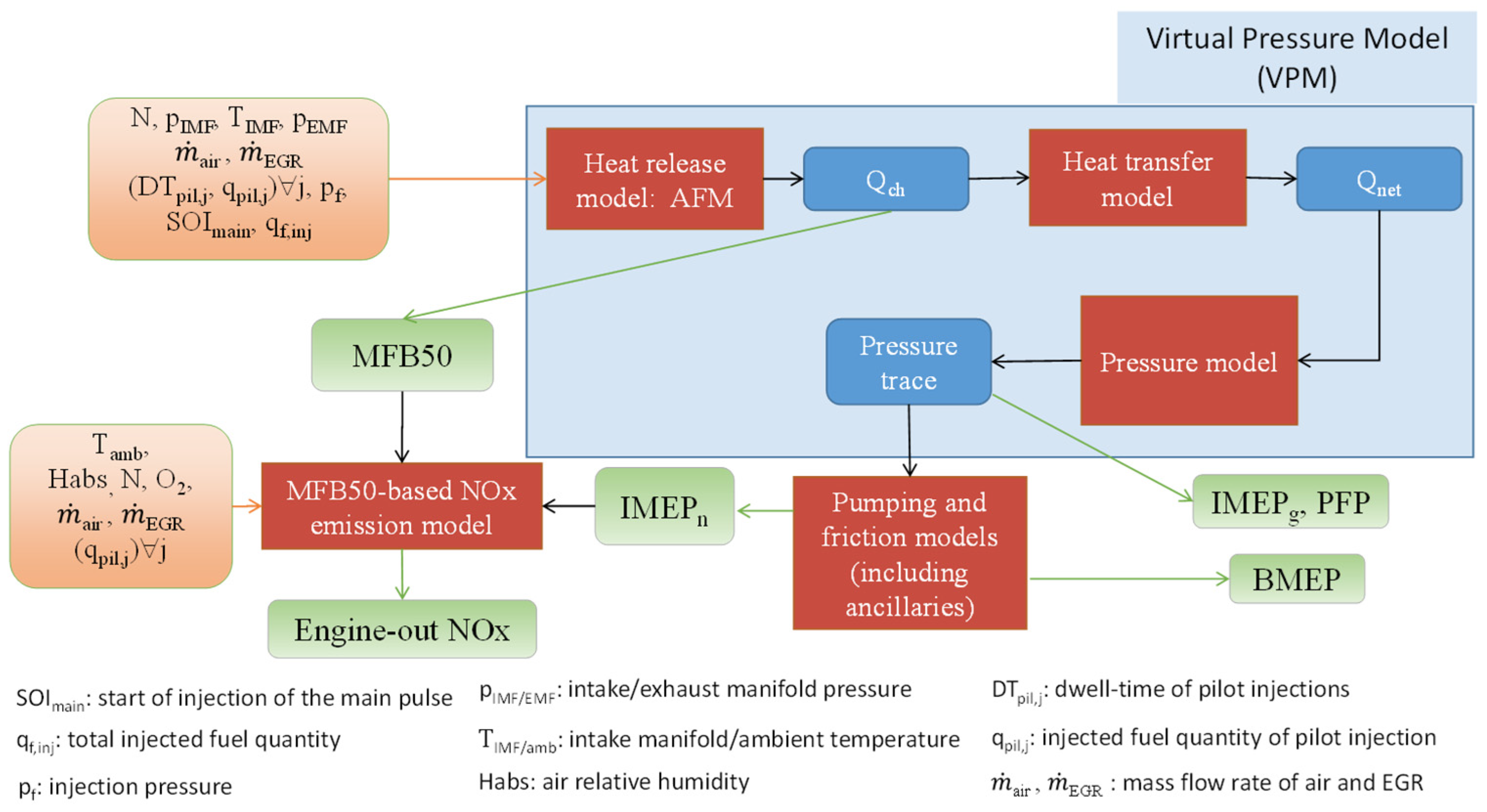

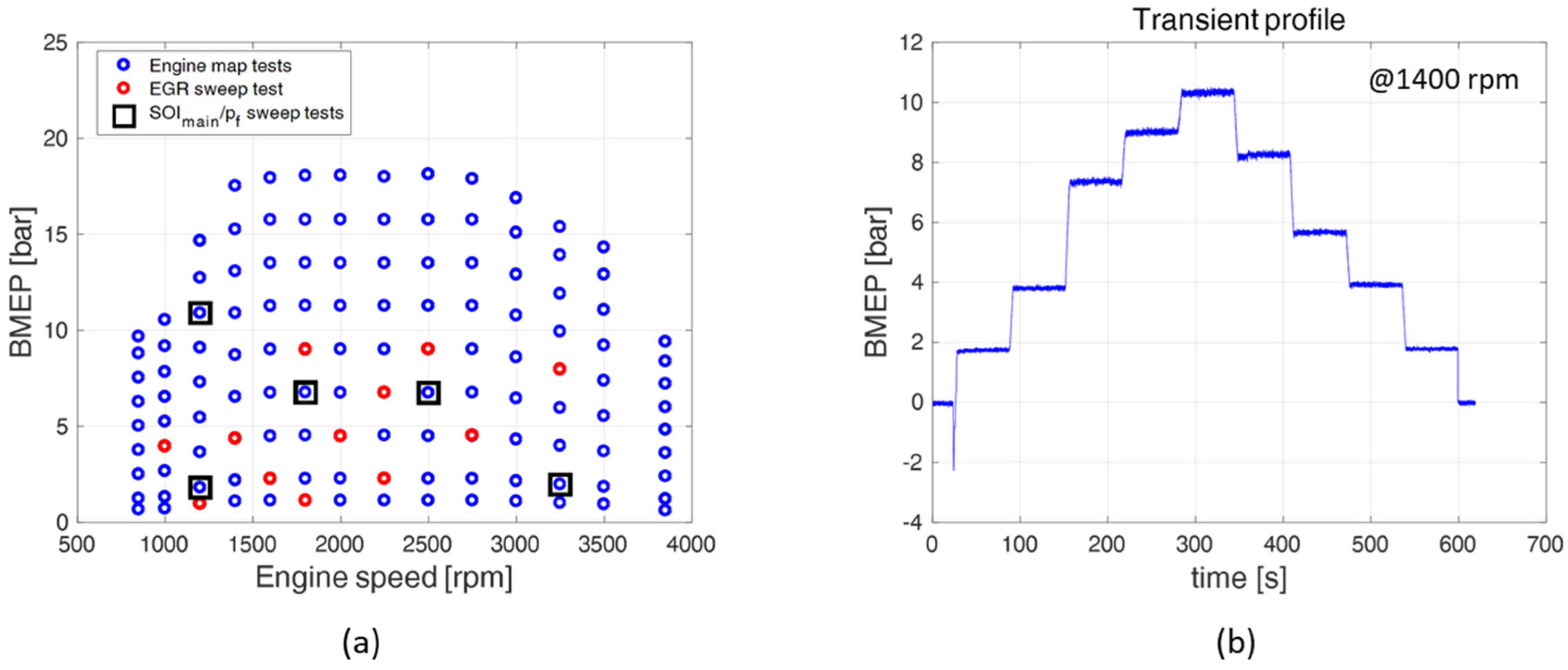

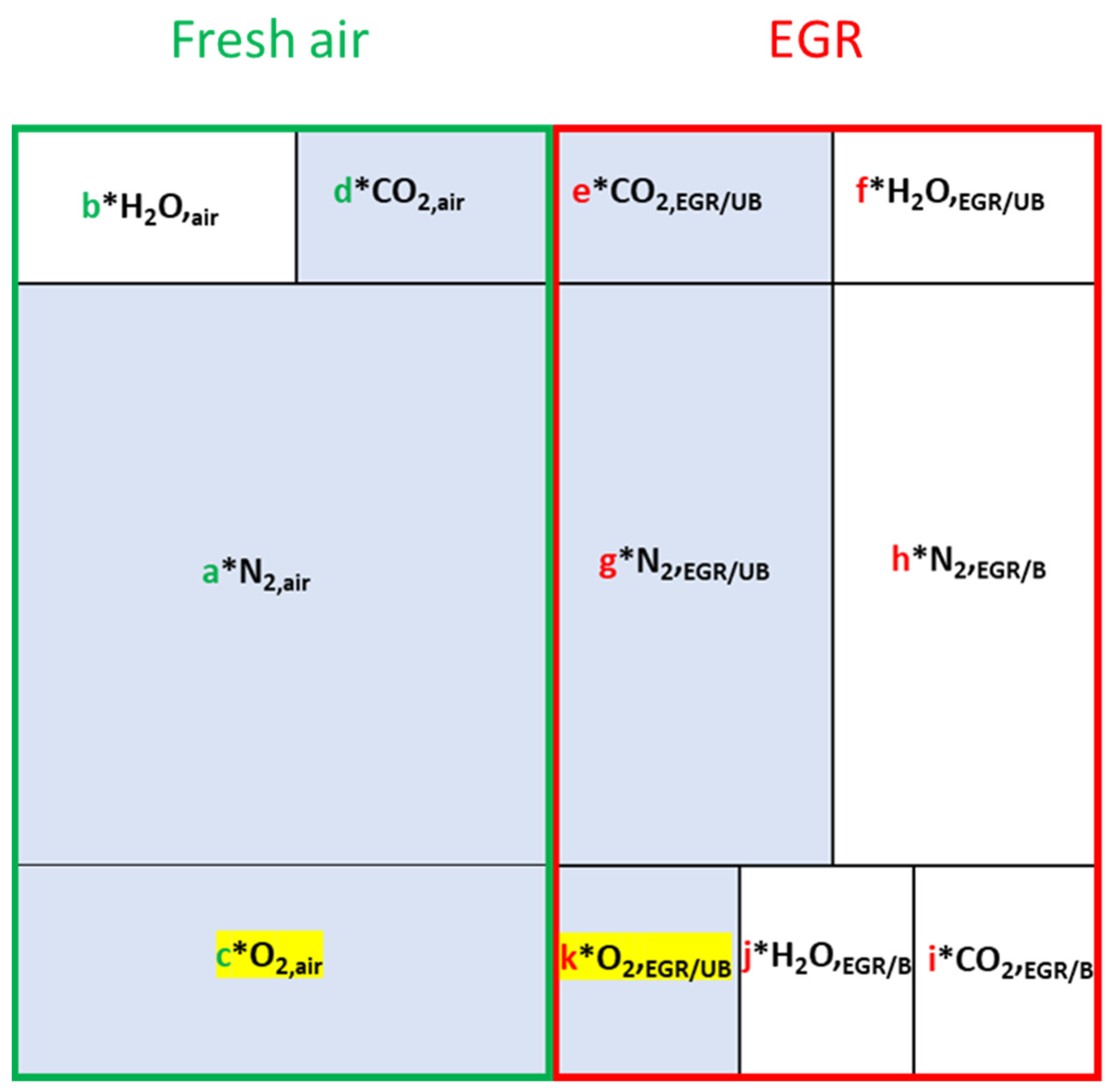
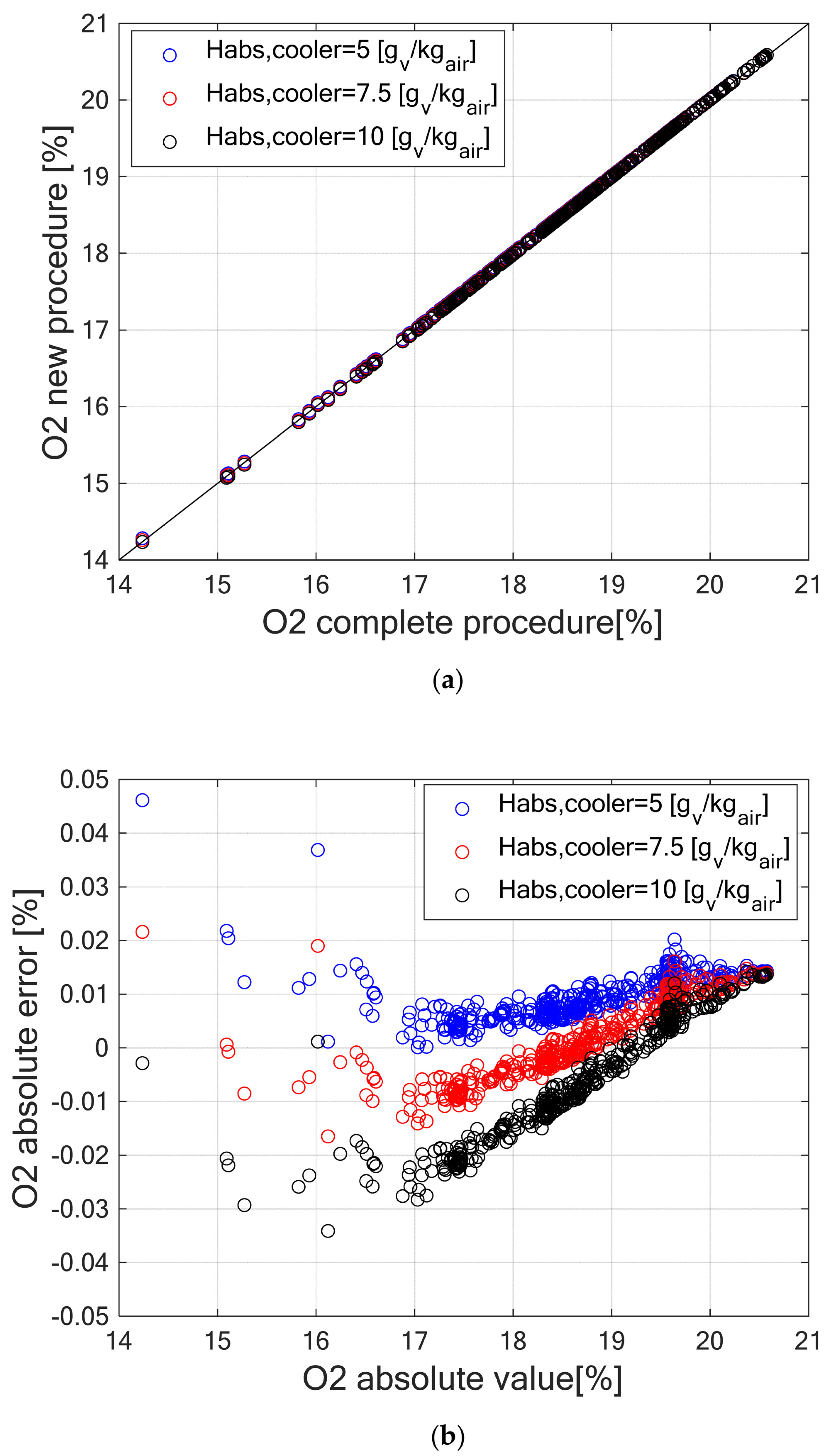


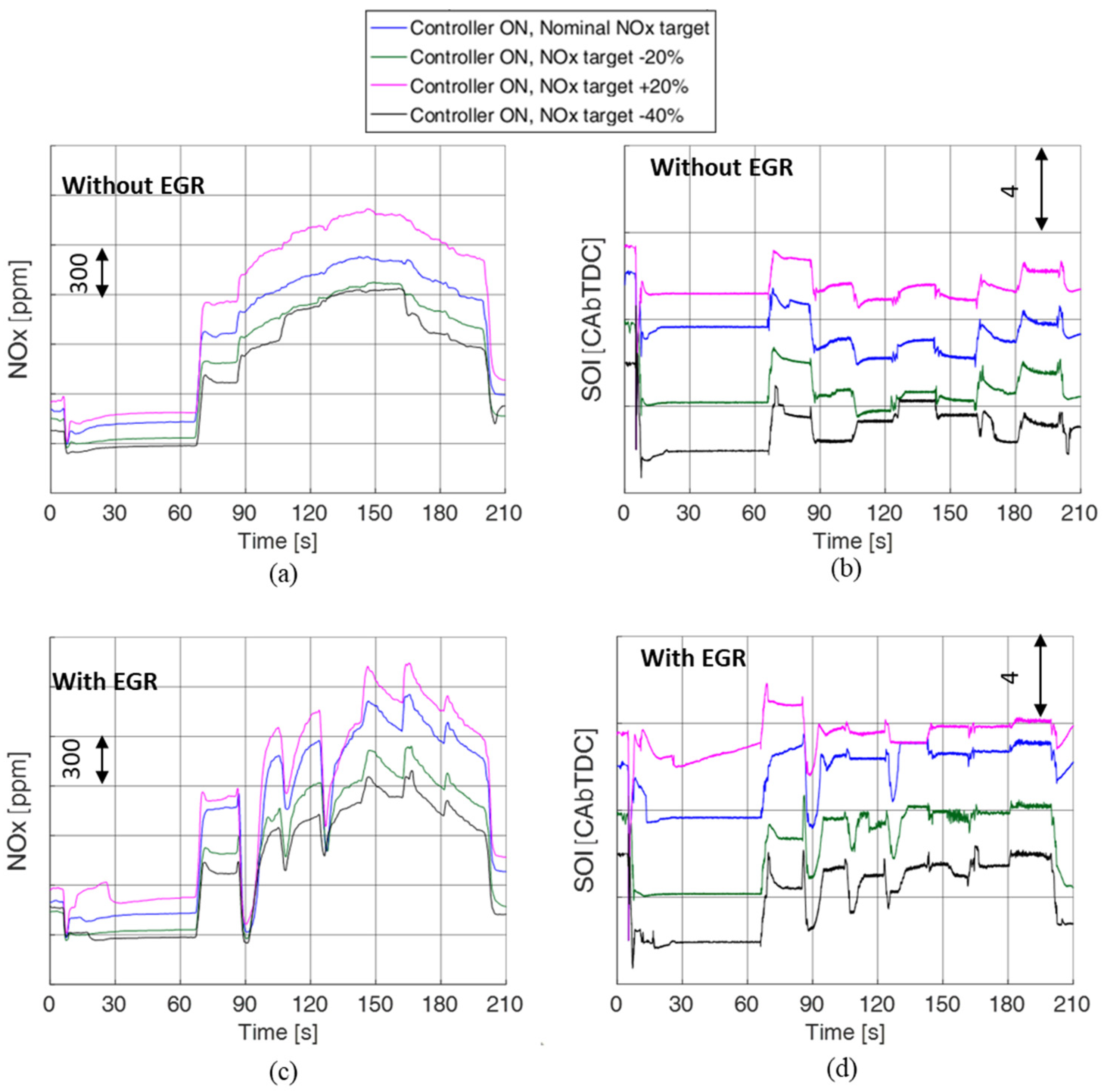



| IRD i60 CO2 H (High Concentration) | IRD i60 CO2 L (Low Concentration) | |
|---|---|---|
| Measured compounds: | CO2 | |
| Lowest Possible Meas. Range: | 0… 0.5% | 0… 0.1% |
| Highest Possible Meas. Range: | 0… 20% | 0… 6% |
| T10–90 Time for CO2: | ≤1 s | ≤1.2 s |
| T90 Time for CO2: | ≤1.5 s | ≤1.8 s |
| Drift: | ≤1% full scale/24 h (at typical laboratory conditions, e.g. ambient temperature fluctuations within ±5 °C/41 °F) | |
| Reproducibility: | ≤0.5% full scale | |
| Flow rate sample gas: | Approx. 60 L/h | |
| Sample gas condition: | Dew point ≤30 °C (86 °F) Particulates ≤5 μm | |
| PMD i60 O2 | ||
| Measured compounds: | O2 | |
| Lowest Possible Meas. Range: | 0… 0.5% | |
| Highest Possible Meas. Range: | 0… 25% | |
| T10–90 Time for CO2: | ≤3.5 s | |
| T90 Time for CO2: | ≤4.5 s | |
| Drift: | ≤1% full scale/24 h (at typical laboratory conditions, e.g., ambient temperature fluctuations within ±5 °C/41 °F) | |
| Reproducibility: | ≤ 0.5% full scale | |
| Flow rate sample gas: | Approx. 60 L/h | |
| Sample gas condition: | Dew point ≤30 °C (86 °F) Particulates ≤5 μm | |
| Cross sensitivity | All paramagnetic gases (identical for all paramagnetic sensors) | |
| Ramp Test | Engine Speed | Load (Accelerator Pedal Position) | EGR | Combustion Controller | NOx Target When the Combustion Controller Is ON |
|---|---|---|---|---|---|
| Ramp test 1 | 800 rpm | 0–60% with intermediate steps | ON/OFF | ON/OFF | Nominal/+20% −20% −40% |
| Ramp test 2 | 1300 rpm | 0–60% with intermediate steps | ON/OFF | ON/OFF | Nominal/+20% −20% −40% |
| Ramp test 3 | 1900 rpm | 0–60% with intermediate steps | ON/OFF | ON/OFF | Nominal/+20% −20% −40% |
| Ramp test 4 | 1100 rpm | 0–60% with different ramp durations | ON/OFF | ON/OFF | Nominal/+20% −20% −40% |
| Ramp test 5 | 1500 rpm | 0–60% with different ramp durations | ON/OFF | ON/OFF | Nominal/+20% −20%/−40% |
| Dataset | Old Usage | Usage in This Paper |
|---|---|---|
| Dataset 1 Steady-state tests and transient test for the 3 L diesel engine | Data used for different activities at Politecnico di Torino [11] | Validation of the new intake O2 concentration evaluation procedure |
| Dataset 2 Transient tests for the 11 L diesel engine | Validation of the combustion controller during the IMPERIUM project [9] | Evaluation of the impact of the intake O2 concentration on the NOx estimation accuracy under transient operating conditions |
| Summary |
|---|
| Intake charge composition: aN2,air + bH2O,air + cO2,air + dCO2,air + eCO2,EGR/UB + fH2O,EGR/UB + gN2,EGR/UB + hN2,EGR/B + iCO2,EGR/B + jH2O,EGR/B + kO2,EGR/UB = L |
| , Habs expressed in gvap/kgair,dry |
| , |
| H2Ocooler | Habs,cooler [gv/kgair] |
|---|---|
| 0.00868 | 5 |
| 0.0127 | 7.5 |
| 0.0160 | 10 |
| Input Type | Controller ON, Nominal NOx Target | Controller ON, NOx Target +20% | Controller ON, NOx Target −20% | Controller ON, NOx Target −40% |
|---|---|---|---|---|
| Ramp test 1, EGR OFF | Reference | +17.44 | −15.77 | −26.62 |
| Ramp test 1, EGR ON | Reference | +13.29% | −19.48% | −30.53% |
| Ramp test 2, EGR OFF | Reference | +21.33% | −16.26 | −24.25% |
| Ramp test 2, EGR ON | Reference | +13.28% | −21.31% | −31.83% |
| Ramp test 3, EGR OFF | Reference | +21.17% | −18.86% | −28.24% |
| Ramp test 3, EGR ON | Reference | +19.85% | −22.71% | −35.81% |
| Ramp test 4, EGR OFF | Reference | +18.99% | −17.89% | −26.41% |
| Ramp test 4, EGR ON | Reference | +14.03 | −14.56% | −28.35% |
| Ramp test 5, EGR OFF | Reference | +20.44% | −18.51% | −25.44% |
| Ramp test 5, EGR ON | Reference | +16.39% | −22.07% | −33.62% |
Publisher’s Note: MDPI stays neutral with regard to jurisdictional claims in published maps and institutional affiliations. |
© 2022 by the authors. Licensee MDPI, Basel, Switzerland. This article is an open access article distributed under the terms and conditions of the Creative Commons Attribution (CC BY) license (https://creativecommons.org/licenses/by/4.0/).
Share and Cite
Finesso, R.; Marello, O. Calculation of Intake Oxygen Concentration through Intake CO2 Measurement and Evaluation of Its Effect on Nitrogen Oxide Prediction Accuracy in a Heavy-Duty Diesel Engine. Energies 2022, 15, 342. https://doi.org/10.3390/en15010342
Finesso R, Marello O. Calculation of Intake Oxygen Concentration through Intake CO2 Measurement and Evaluation of Its Effect on Nitrogen Oxide Prediction Accuracy in a Heavy-Duty Diesel Engine. Energies. 2022; 15(1):342. https://doi.org/10.3390/en15010342
Chicago/Turabian StyleFinesso, Roberto, and Omar Marello. 2022. "Calculation of Intake Oxygen Concentration through Intake CO2 Measurement and Evaluation of Its Effect on Nitrogen Oxide Prediction Accuracy in a Heavy-Duty Diesel Engine" Energies 15, no. 1: 342. https://doi.org/10.3390/en15010342







